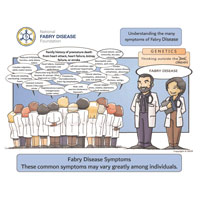Fabry Disease Pulmonary Symptoms
Obstructive (Chronic Obstructive Pulmonary Disease, COPD) and constrictive lung disease have both been documented in subgroups of Fabry patients. It is often documented as wheezing, dyspnea (difficulty in breathing resulting in shortness of breath), or bronchitis. A chronic cough is a common complaint in men as well as women. While the cough may be worsened by restrictive airway disease or tobacco use, it can occur in individuals without these risk factors.
Exercise intolerance in Fabry disease is typically attributed to hypohidrosis, pulmonary disease, or cardiomyopathy.
Spirometry and exercise testing with monitoring of blood pressure should be performed at confirmed diagnosis and every two years thereafter. This testing, along with the ECG and echocardiogram, is especially helpful for distinguishing causes of exercise intolerance and fatigue. If pulmonary involvement is significant, induced sputum (mucus that is brought up from the lungs by coughing) may show typical Fabry lamellar (covered by a thin layer or membrane) inclusions, but bronchoscopy and/or a lung biopsy may be required to rule out other etiologies for pulmonary disease.
The way obstruction is GRADED based on the results of a spirometry exam is based on the FEV1 (forced expiratory volume in one second). Normal is generally regarded as around 80% of predicted (based on age, height, race, and gender). For instance, an FEV1 of 60 to 69% of predicted in arbitrarily defined as moderate severity.
Note: Spirometry is the measurement, by a form of gas meter (spirometer), of volumes of air that can be moved in or out of the lungs.
As additional information, obstruction is DIAGNOSED based on the ratio of FEV1 to FVC (forced vital capacity). The forced vital capacity is the total amount of air that a person is able to maximally exhale. Essentially, the ratio tells a physician how fast you are able to exhale. Taking longer to exhale is the definition of obstruction. (If you have a background in physics, think of it as resistance to flow through narrower pipes.) A normal ratio falls in the range of 75-85% depending on a variety of factors. A ratio below normal indicates an obstruction. This number in and of itself has no real significance other than defining the process.
Note: The primary sources of this information including the proposed periodic assessments comes from: the September, 2006 Genetics in Medicine journal article entitled "Fabry disease: Guidelines for the evaluation and management of multi-organ system involvement, the emedicine journal article entitled "Fabry Disease", updated periodically (emedicine - Fabry Disease), and a practicing pulmonologist's explanation.































Connect With Us